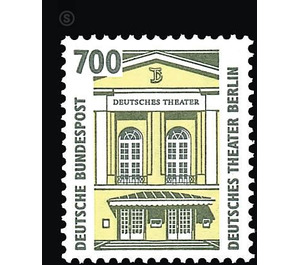Postage stamps: sights - Germany / Federal Republic of Germany 1993 - 700 Pfennig
Theme: Architecture
| Country | Germany / Federal Republic of Germany |
| Issue Date | 1993 |
| Face Value | 700.00 |
| Color | yellow white |
| Perforation | K 14 |
| Printing Type | indirect 2-color letterpress |
| Stamp Type | Postage stamp |
| Item Type | Stamp |
| Chronological Issue Number | 1564 |
| Chronological Chapter | GER-BRD |
| SID | 636447 |
| In 29 Wishlists | |
The Deutsches Theater and its Kammerspiele are among the most traditional and oldest Berliner Sprechbühnen. The façade front of the two theaters comes from the 1830-1850 in the courtyard and garden area behind the Schumannstraße in the eastern part of the city built theater complex. This included the »Casino« built by Friedrich Wilhelm Deichmann in 1842 and the »Summer Theater« built by his son in 1848. In 1850, the Friedrich-Wilhelmstadt Theater was built from the converted summer theater with winter stage - this forms the foundation of today's German Theater. The previously well-known architectural image of the German theater stems from the reconstruction measures in 1905 ago, which were made at the instigation of Max Reinhardt. The neo-classical façade was in keeping with the taste of the time at the beginning of the 20th century. The facades of the two theaters dominate the small square created after the Second World War by demolition. The view of the Kammerspiele corresponds largely to the form she still had in function as a casino and dance hall. Reinhardt had around 1906 only the window parapets removed and changed by installing French windows, the overall appearance. This architecture from a time when the two theaters gained world fame was restored in the early 1980s. Both facades have been renovated and redesigned architecturally by additional arrangement of shutters and a new color scheme of all the fronts, which have grown historically different from the time of origin. Since the festive opening as DEUTSCHES THEATER in 1883, the house has stood for great stage and actor theater. Principals such as Otto Brahm, Max Reinhardt, Heinz Hilpert and Wolfgang Langhoff have shaped the ensemble-maker and repertoire for decades and established the artistic line valid to this day. From 1905 Max Reinhardt began to realize his groundbreaking ideas for this house, which became at the same time the center of his stage empire. Based on a repertoire, which especially Shakespeare, the German classical and the modern took over, with outstanding mimes and numerous tours, the German theater and its Kammerspiele advanced to the stage of international rank and international charisma. Here began and completed great acting careers. The unbroken fame of the house lasts to the present day. And the theater world understood and acknowledged this: the critics of the journal "Theater heute" awarded the Deutsches Theater and its Kammerspiele the "Theater of the Year" in 1991 and 1992 in acknowledgment and affirmation. For the Deutsches Theater and the Kammerspiele today stands a name: Thomas Langhoff. In the summer of 1991 he was the son of Wolfgang Langhoff (director of the house from 1946 to 1963), elected as a candidate of the ensemble candidate for the new director. Thomas Langhoff is not a man of confrontation and violent change. Rather, he feels obligated to the tradition line founded by Max Reinhardt, which was also followed by Heinz Hilpert (artistic director from 1934 to 1944) and then his father: fifty percent classic, fifty percent modern. The new artistic director can support himself with his concept of an ensemble of first-class actors, who in Berlin are hardly comparable to one and in Germany and beyond only a few, as well as to the stylistically diverse productions of well-known directors, which are distinguished by their high artistic level. (Text: Deutsches Theater and Kammerspiele, Berlin)


